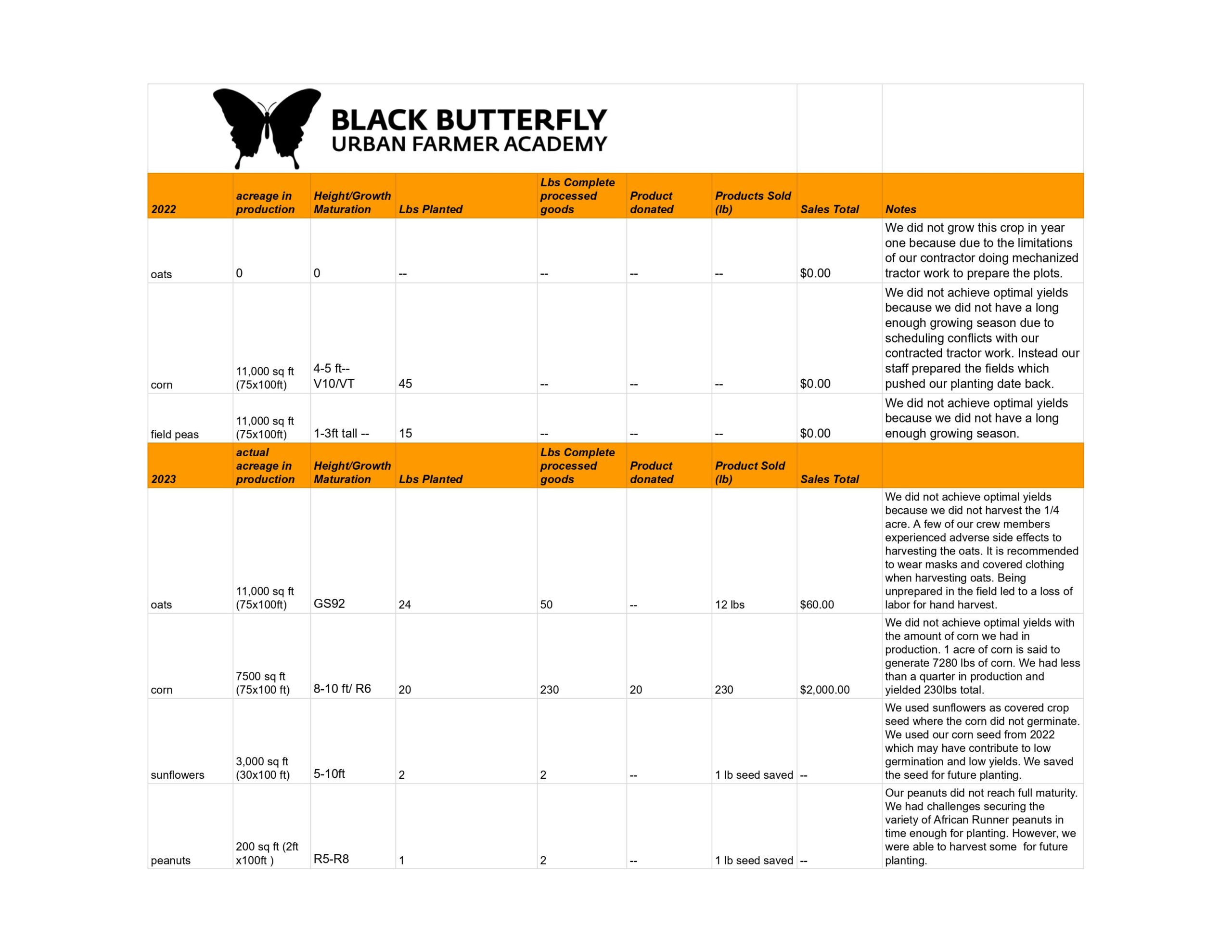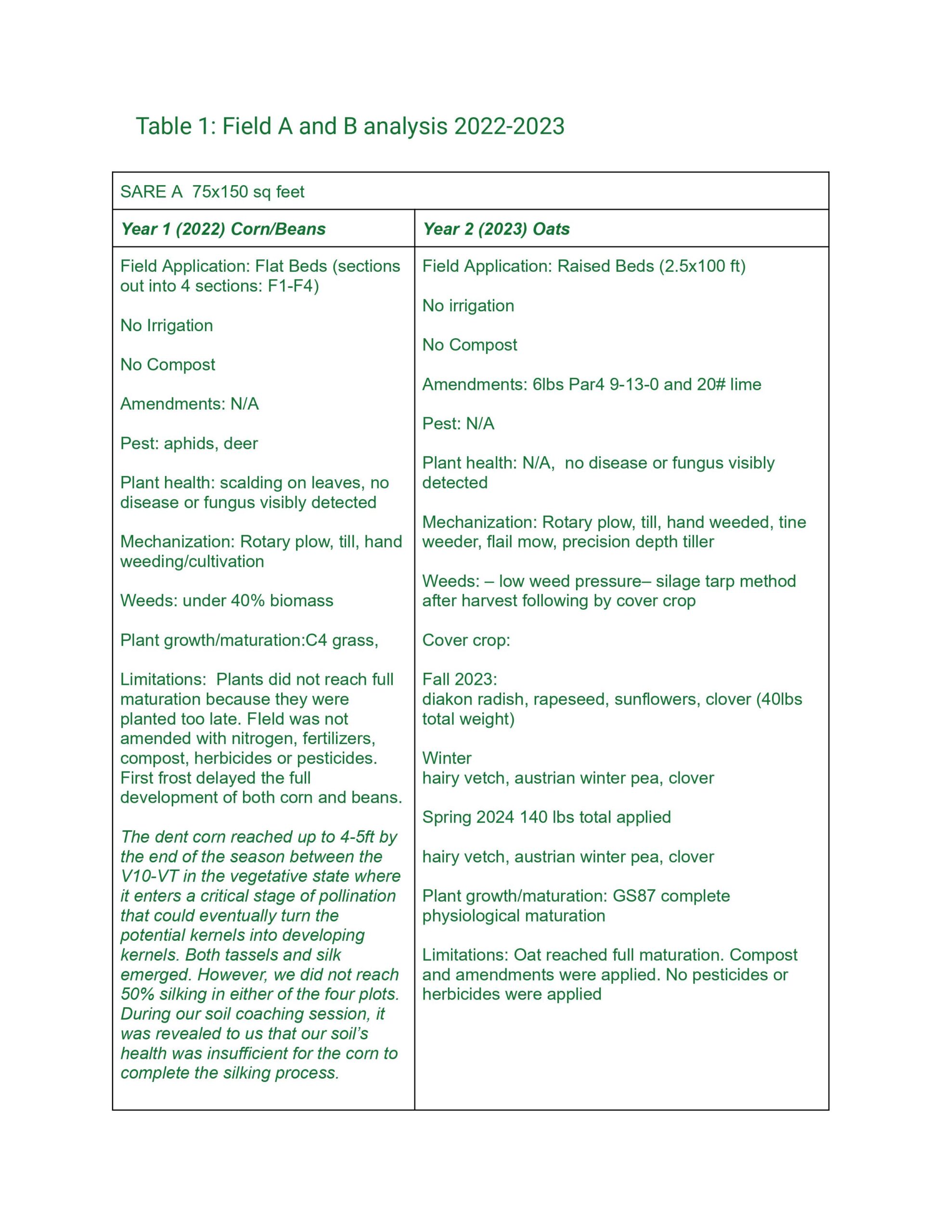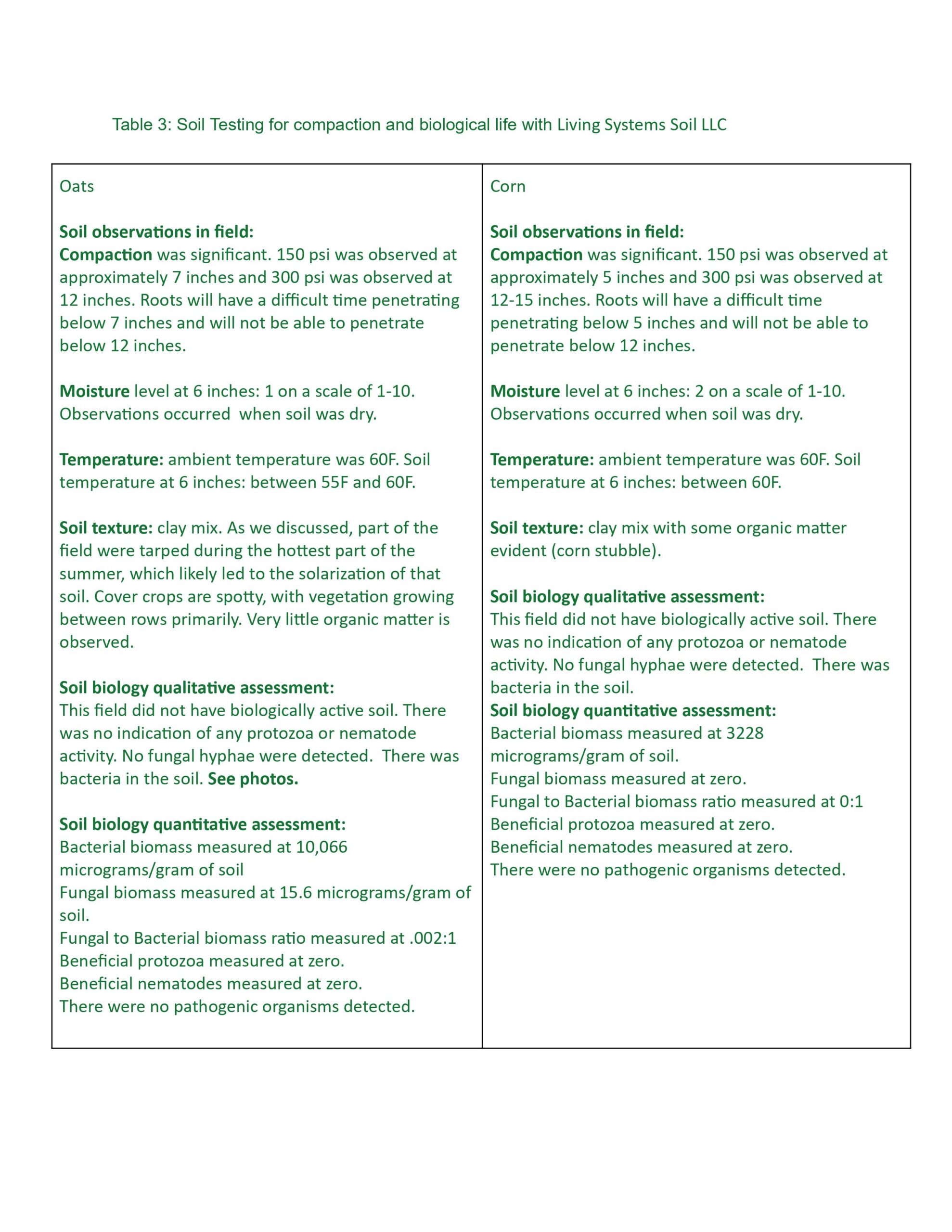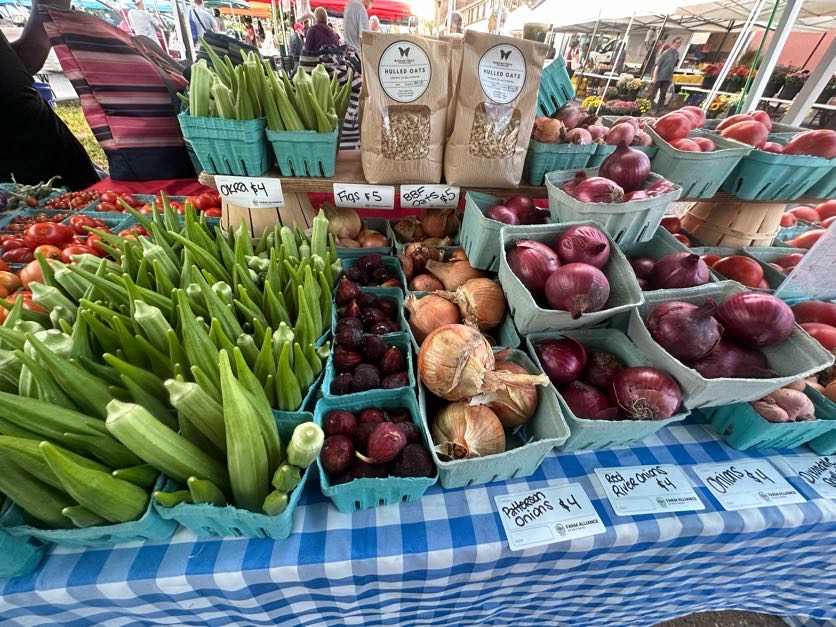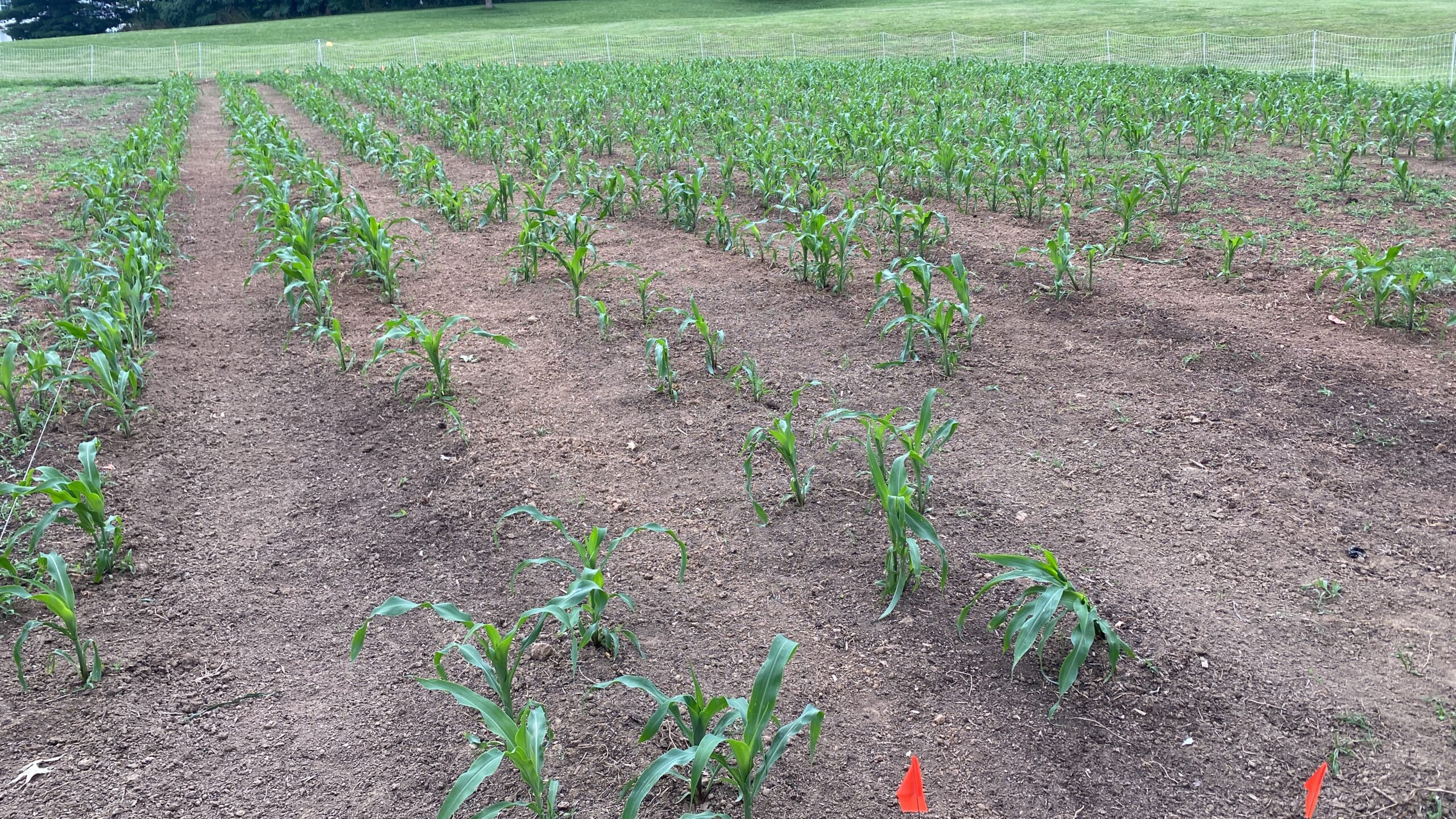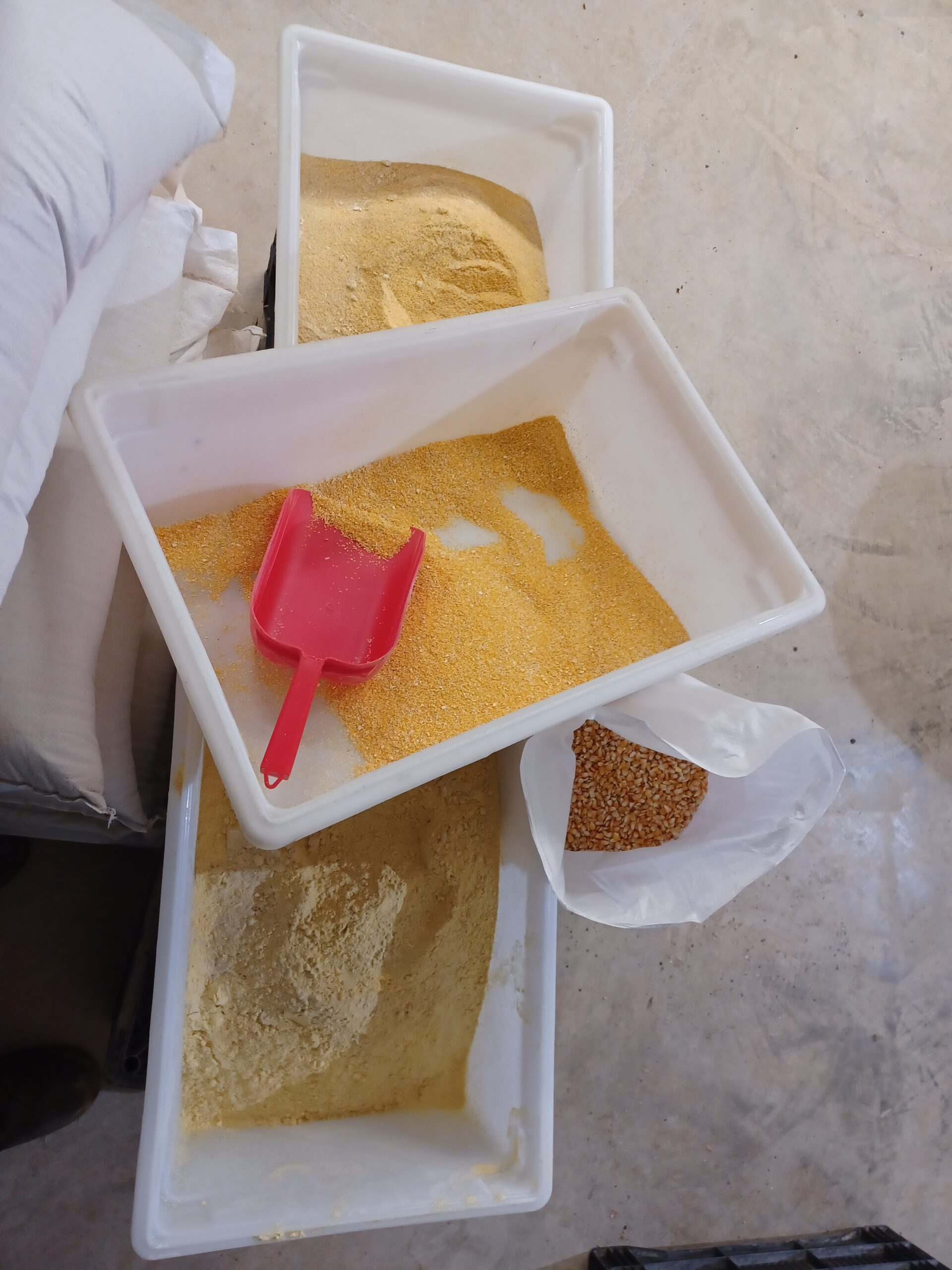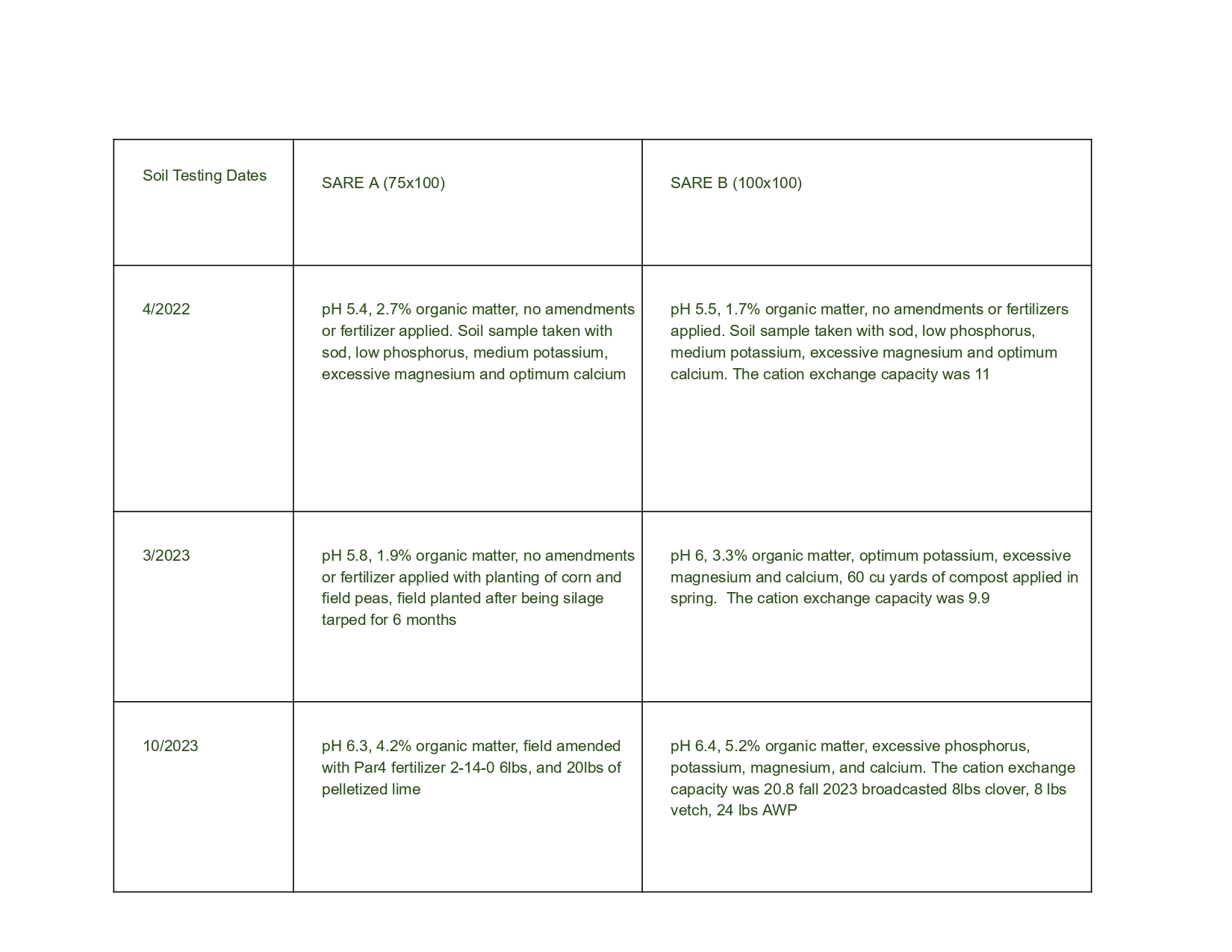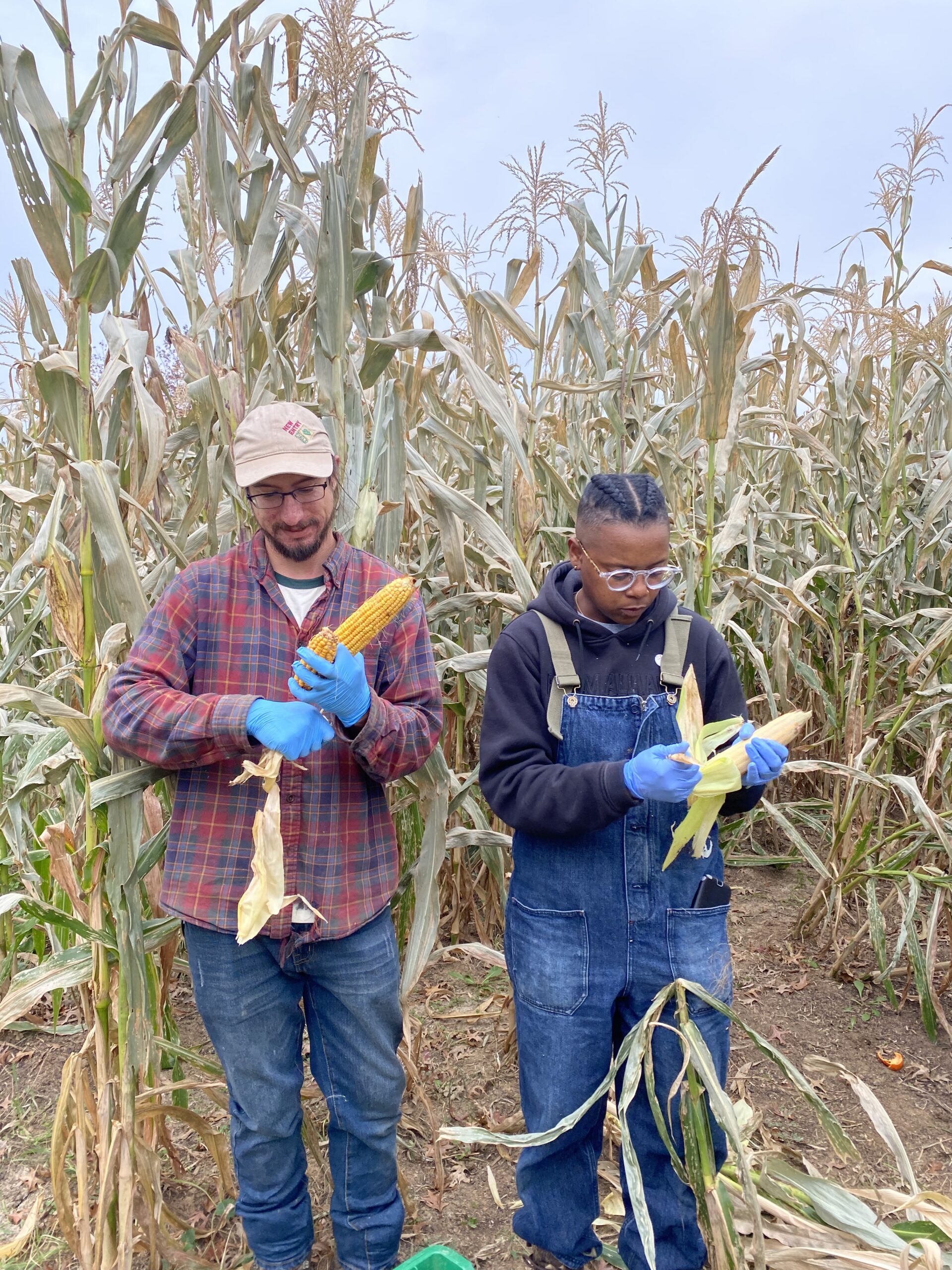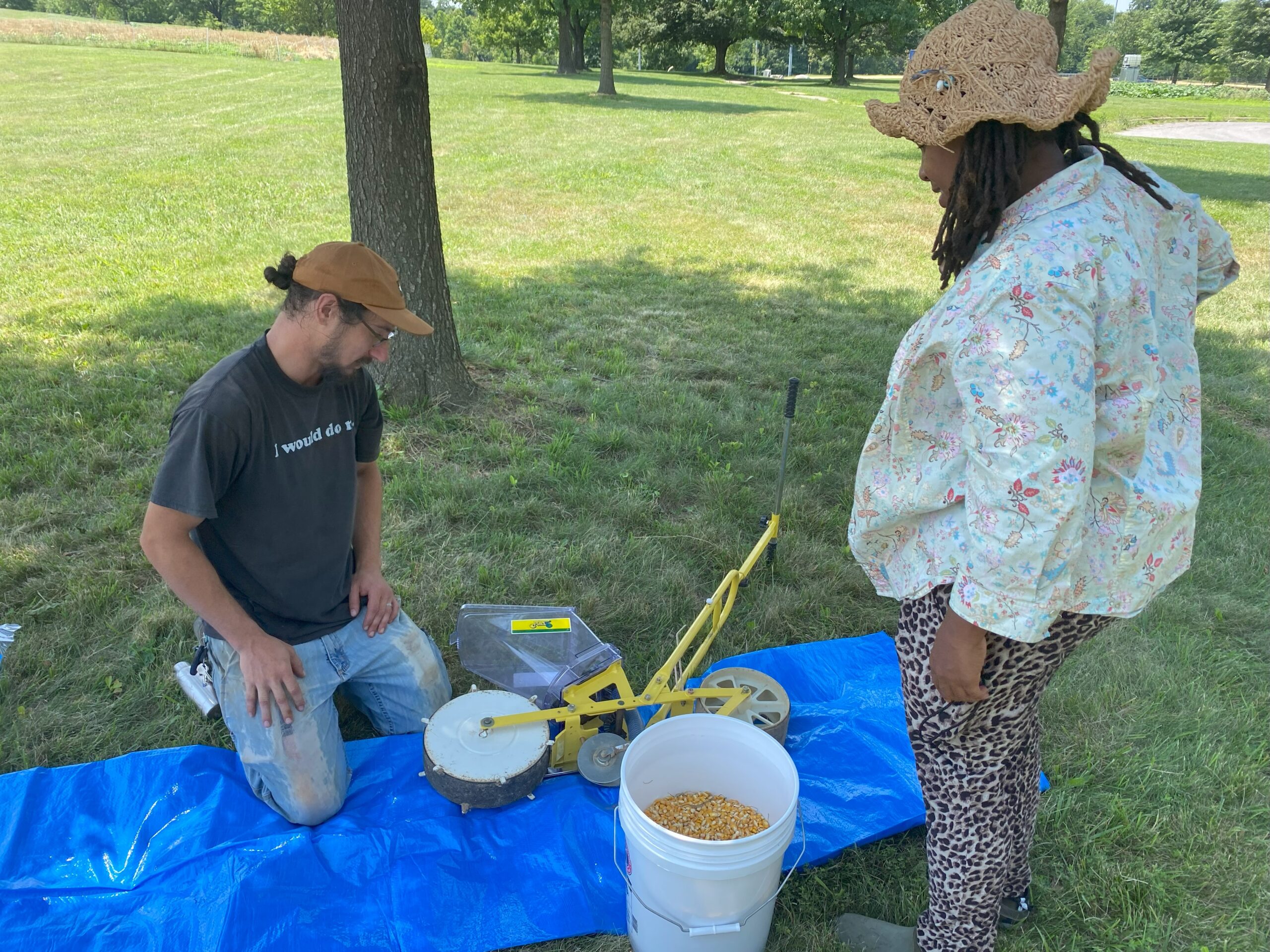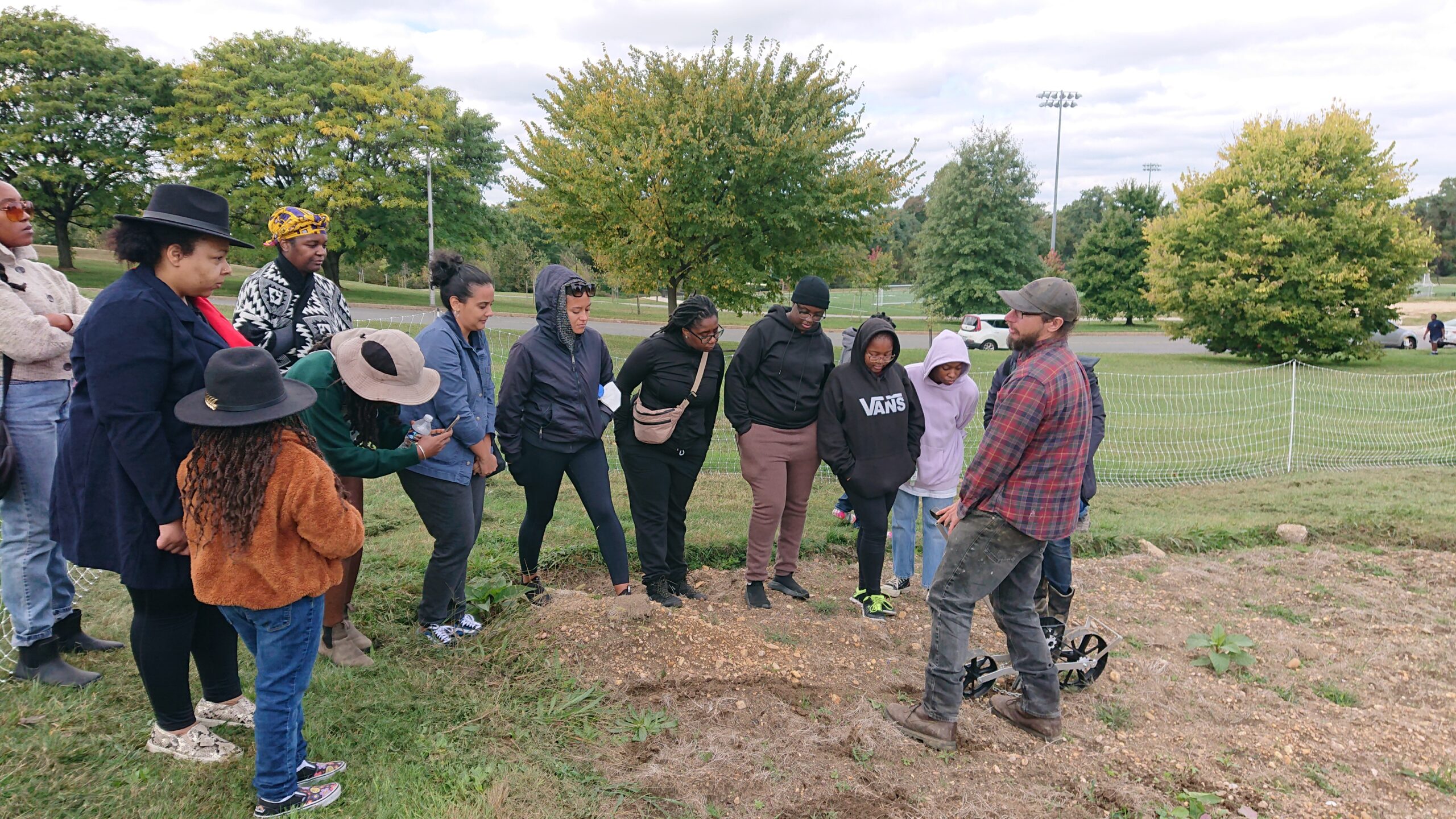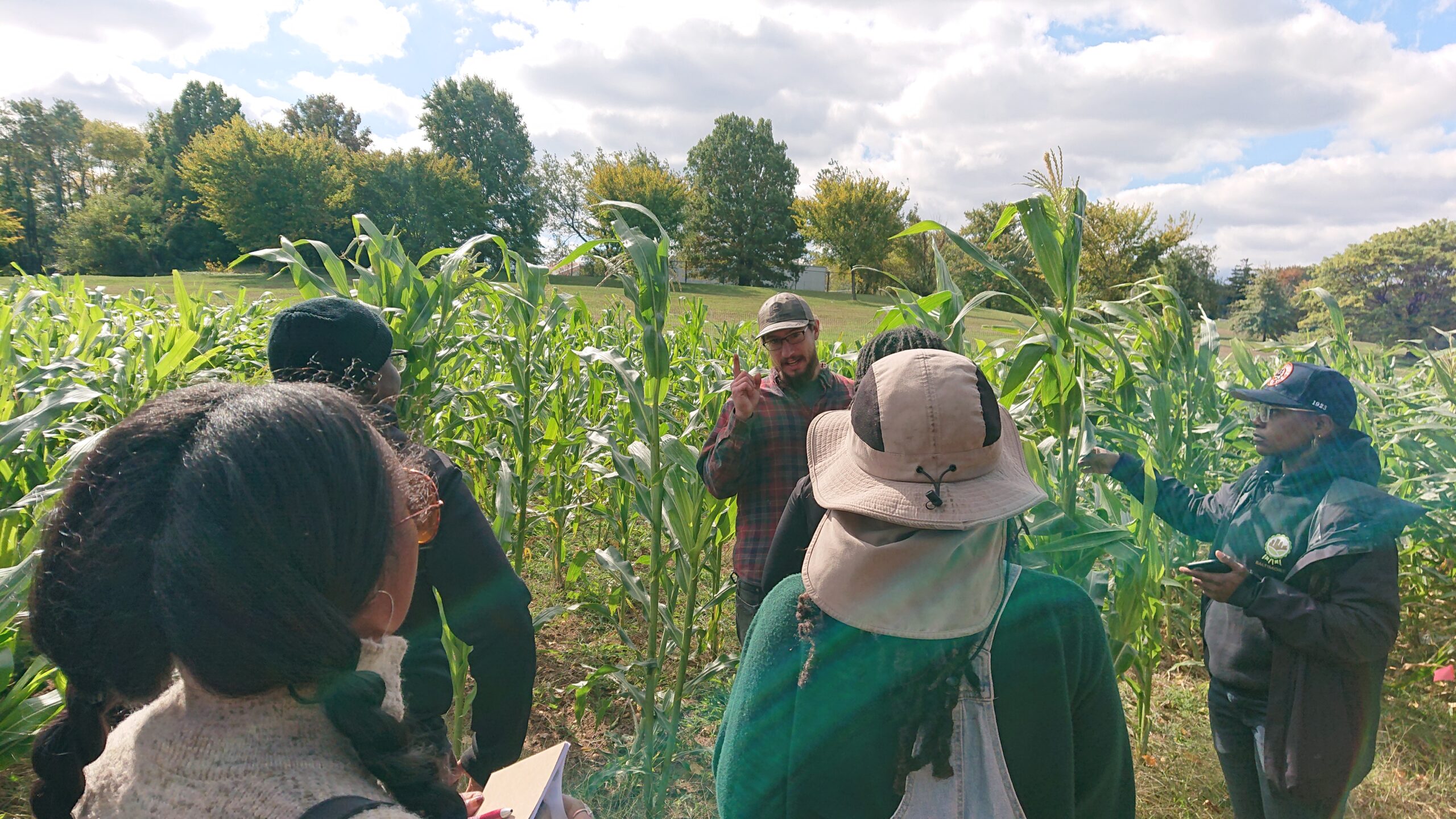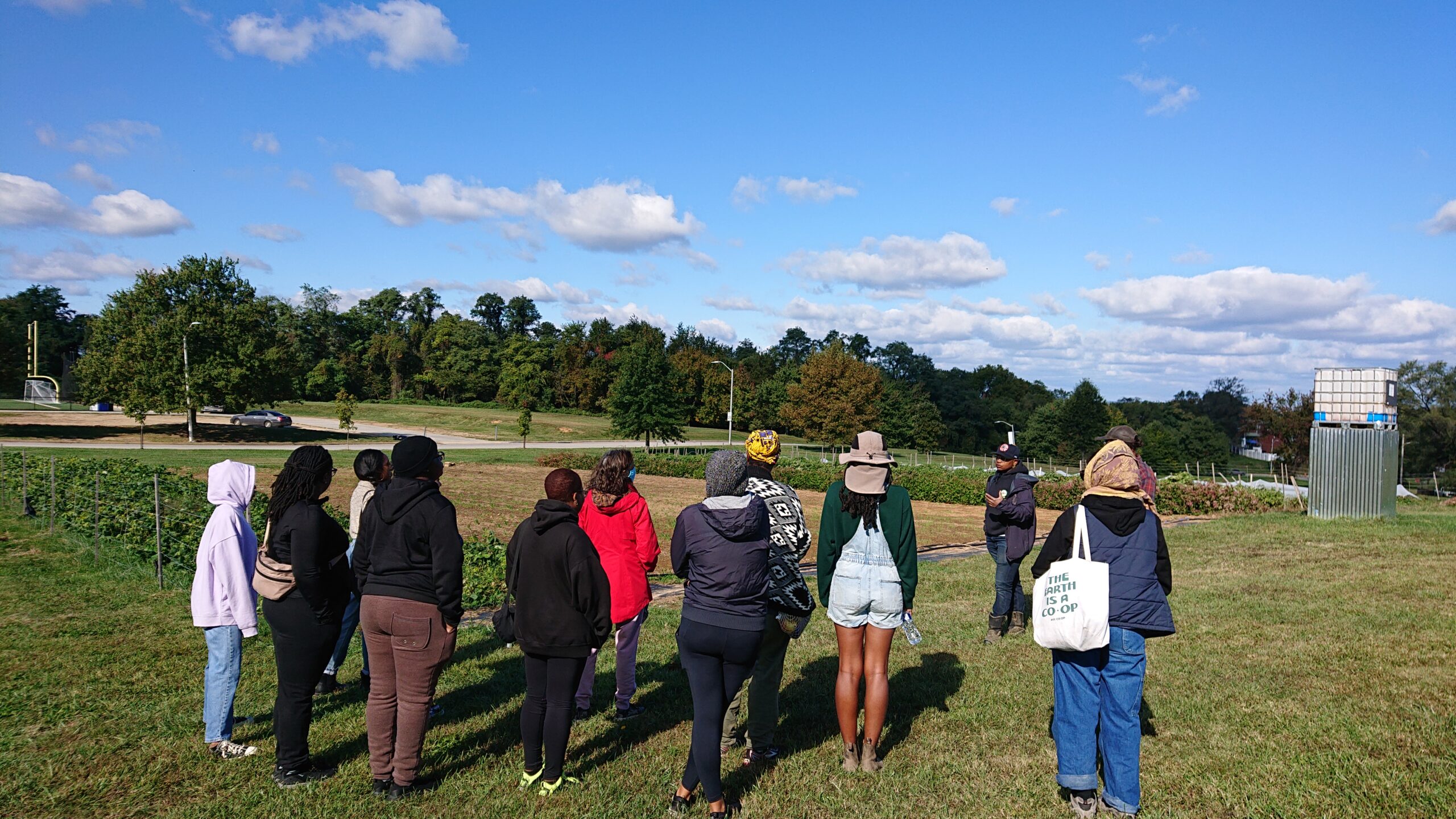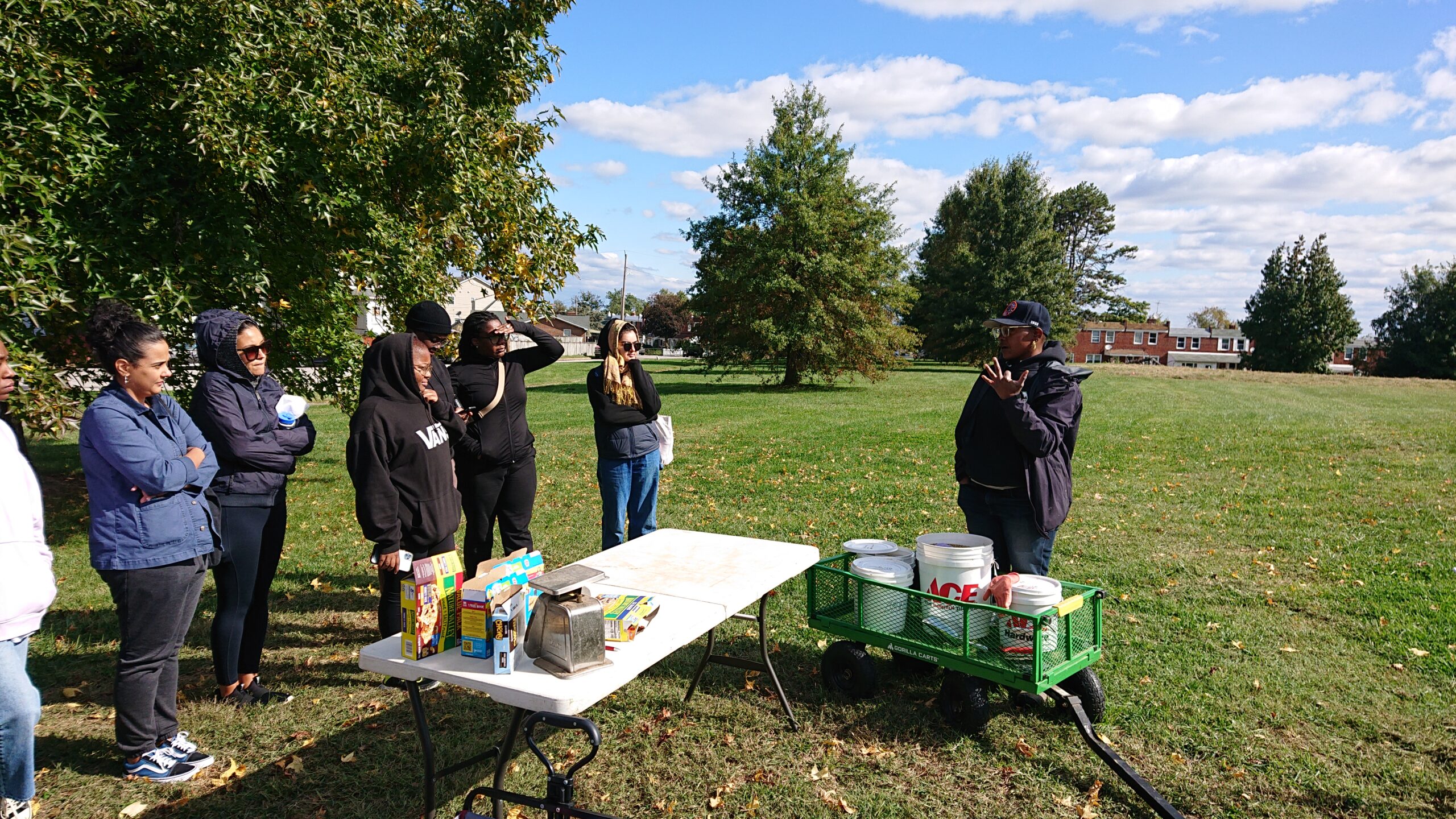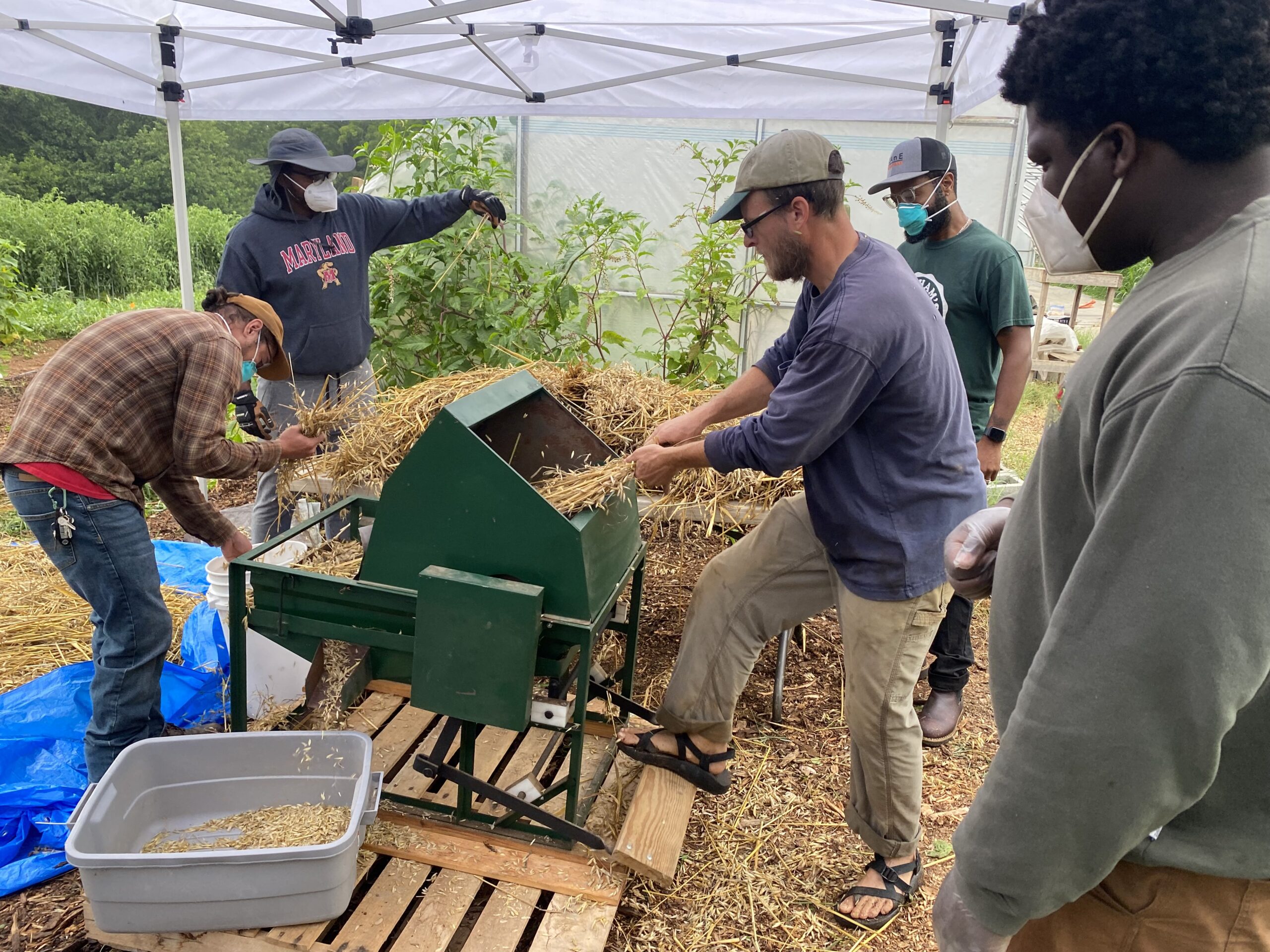Final report for FNE22-021
Project Information
This project sought to explore and demonstrate the profitability of sustainably grown legumes and oats over two years, and whether they can be grown with enough yields to be profitable in the direct-to-consumer and wholesale markets in Baltimore City. Our methods included weighing and recording all seed weights at planting and harvest, plant growth by height, plant health (color of foliage), weed and pest pressures. Both plots received soil testing, were solarized and tilled during the 2022 summer season.
In 2022, Plot A was partitioned into 4 mini plots planted on different dates: F1: corn and beans intercropped, F2: corn and beans, F3: corn, F4: corn/beans. Crops in Plot A: F1 and F3 had the lowest germination rate and were most susceptible to pests. We assume these plots did not grow as well because of malfunction with our seeder and planting midway into the growing season. Plot B was planted in a cover crop mix known for weed suppression, scavenger qualities of nitrogen and other leachable nutrients and excellent fall growth and biomass.
We designated a test plot of oats in a nearby field that has been amended with compost and essential nutrients to compare and contrast data points. The test plot of oats serves as cover crop for an existing field and deer deterrent from Plot A and Plot B.
During 2023, our efforts were concentrated on two plots, each covering 10,000 square feet, where we grew a diverse array of crops. We dedicated one field to cultivating corn and sunflowers, while oats were the sole focus of the other field.
Data regarding soil health, yields, labor and expenses communicate that it is not profitable to grow grains on a small scale without ideal soil health, appropriate field preparation, advanced equipment/materials and mechanized equipment to offset labor costs and expenses. Though this project was not profitable, we successfully grew 17,000 square feet of oats and corn that were highly favored and established sales avenues including a weekly farm stand, popup markets, and vending at farmer conferences.
The soil tests results indicated that we had to continue building the soil. Oat residue in the field increased our organic matter in our fall soil tests. Mushroom compost was added to the corn and sunflower fields showing a gradual increase in organic matter. Most notable in the corn field was the significant increase in the cation exchange capacity.
This project sought to explore and demonstrate the profitability of sustainably grown legumes and grains over two years, and whether they can be grown with enough yields to be profitable in the direct-to-consumer and wholesale markets in Baltimore City. This project was designed to show our entire network but specifically the 37 Black farmers in our existing Farm Alliance membership, trainees and interns whether it is economically viable for them to devote their own farms' resources to growing these crops at their micro-scale urban farms. Using our teaching farm in South Baltimore to teach Black urban farmers to grow these crops, some of which were African American heritage crops, our objective was to help these farmers adopt new crops that will improve their sales, conserve their soils' health, and thus improve economic outcomes on their urban farms in the long term.
The Problem: Farm Alliance of Baltimore has around 80 farmers and community gardeners in its membership, around 46% of whom (37) are Black. Baltimore is a majority-Black city (63%), Black farmers are a growing sector here, and yet we lack market support and opportunities for Black urban farmers. Farm Alliance of Baltimore is working actively to increase support and remove barriers for Black urban farmers, placing them and their needs at the center of our programs. These farmers, including our trainees in the Black Butterfly Urban Farmer Academy funded by a current SARE Research & Education grant, tell us that they want more examples and training in how to sustainably grow crops that our majority-Black communities will eat. Farmers in our membership, as well as our trainees, will learn that small grains and culturally relevant legumes such as black-eyed peas can be grown at a small-scale using sustainable methods such as low and no-till planting methods, cover cropping, apiculture, killed mulches, green manure, trap cropping to reduce deer pressure, and more.
With this project, we will lay the groundwork for creating economic and marketing opportunities for beginning and burgeoning Black urban farmers by demonstrating that storage crops such as oats and dried beans, can be grown sustainably at a micro-scale. However, research shows the methods that we will use to grow these crops will have a much lower environmental impact and much higher benefit on the overall soil health. We will explore the profitability of these crops and whether they can be grown with enough yields to be profitable in the direct-to-consumer and wholesale markets in Baltimore City. Black farmers in our existing Farm Alliance membership and the trainee farmers in the Black Butterfly program will benefit from the results of this research project.
We expect this to help improve quality of life for farmers and their families in Baltimore by helping to increase food sovereignty and self-sufficiency for urban communities, a goal that is shared with our other SARE-funded grant program, the Black Butterfly Urban Farmer Academy. Because we are concurrently running a SARE-funded farmer training program in addition to this SARE farmer grant we are proposing to start in March of 2022, and with some of the same staff involved, SARE will also likely see improved outcomes from both grants. Our expected outcomes for this grant include:
- We will demonstrate sustainable methods for growing oats and legumes in Baltimore City on the Black Butterfly Teaching farm — cover cropping, nitrogen fixation, trap cropping, intercropping planting methods and the other methods listed in the Proposal Overview-- and our research will answer the question of how these methods affect yields compared with the more prevalent conventional growing methods.
- We will establish a market initiative to increase diversity in the locally-grown food chain. By bringing our crops to our direct-to-consumer stand at the 32nd St. Farmers Market in Waverly in Baltimore, we will be able to increase human-scale small grain production in a city-based food market.
- We will demonstrate the economic viability of small grain and dried beans production in small urban plots for other small diversified farmers. With roughly half an acre, across two 10,000 square foot plots at our teaching farm, we will be able to show other farmers in our membership network how to grow these crops at a scale much closer to the scale of their urban farms than we normally see in rural farm trials. To do this, just as doctors hold Grand Rounds in teaching hospitals to demonstrate medical techniques, we will host a series of field days for FAB members and other growers in the area, to demonstrate our progress and the methods we are employing on these crops as they grow on our farm. We will show the beneficial impact of a 2-year cover crop rotation on soil health in an urban plot.
- We will measure the macro and micronutrients in our soils with tests at the beginning and end of each cycle. Tests at the start of the program and ending to see if there is a marked change from when we started to when we ended.
The Black Butterfly Farm is a project of the urban agriculture non-profit organization the Farm Alliance of Baltimore. Our mission is to use connection, resource sharing, and collective advocacy with respect to food, land and water to expand communities’ self-determination and power. On a 6.7 acre site located in South Baltimore, we operate a teaching and demonstration farm that will be the primary teaching and incubator site for the Black Butterfly Urban Farm Academy. Of the four farmers we have on staff, 3 are dedicated to the management of our farm. With over 30 years of combined experience, we are embarking on our second full season of teaching intensive, urban, human-scaled production methods and growing product for farmers’ markets, restaurants, and community partners. We will be purchasing specialized equipment to better execute the project this year.
Cooperators
- (Educator and Researcher)
- - Technical Advisor
- (Educator)
- (Educator)
Research
In this study, we planted roughly half an acre (2 10,000 square foot plots) in oats and dent corn. We tried to grow dried beans and peanuts for 2 years but had unsuccessful results.
It was our attempt to answer a nagging question for many human-scaled diversified growers: Can we grow small grains, legumes and other nutrient-dense, shelf stable foods on a small human scale with few inputs while simultaneously improving the soil health? We knew that many small-scaled farmers are searching for ways to diversify their offerings without creating more layers of difficulty or complication. We also knew that grain raising would create access to highly-nutritious foods in a market that often does not receive nutrient-dense foods with longer shelf-life. Our aim was to demystify grain and dried bean production for the small urban farmer and create possibility to incorporate new production models into small diversified food farms' systems. Finally, we planned to collaborate with other farmer-processors and mills in the area to make these foods available to consumers.
Our process included the following: Marking off the fields and taking soil core samples from two 10,000 square foot plots on the Black Butterfly Teaching Farm in Farring-Baybrook Park in south Baltimore City.
We sent the soil samples to University of Delaware's soil sciences laboratory for analysis of nutrient composition and amendment recommendation in preparation for planting oats, corn, and beans.
During the winter of 2022, we solarized the land to create stale seed beds while still keeping the moisture and biomass from the existing vegetation.
We planted a "catch" crop of Streaker hulless oats on fallow solarized ground in March 2022 to harvest in early-June 2022. We expected to harvest about 500 pounds. We were unable to harvest any oats in 2022.
We did not successfully grow or harvest beans during either year of this study.
For the 2023 season and second year of our study, our efforts were concentrated on two plots, each covering roughly 10,000 square feet. We dedicated one field to dent corn and sunflowers, while oats were the sole focus of the other field.
The oat harvest was challenging due to the lack of access to equipment and expertise to harvest. Once proper moisture content in the grain was achieved, the oats were harvested by Farm Alliance staff and interns. When the oat harvest was complete, we then transported the oats to be threshed, cleaned, sorted and bagged. Back at the farm, the oat residue was mowed and incorporated into the field with a spader to retain the biomass. We then planted beans and corn for a fall harvest.
We used a Jang TD-1 seeder to plant Reid's Dent Corn on 1 10,000 square foot plot. The corn was cultivated twice before being hand harvested with the help of volunteers on November 7 and 8, 2023. The corn cobs were dried down at Next Step Produce. The farmer processor shucked, cleaned and processed the corn. Our efforts yielded approximately 240 pounds of marketable corn product.
We conducted at least 4 soil nutrient tests on the fields over the course of the study. We pulled soil samples on the plots in late-winter of 2022 to get a baseline of available nutrients to the "catch" and "cash" crops. Then pulled samples again in the late-fall of 2022, after the first bean harvest. We expected a significant increase in nitrogen levels due to the nitrogen fixation properties of legumes and increased soil aeration and moisture content from deep and extensive root growth. We pulled soil nutrient samples at the same times of year in 2023. This gave us a total of 4 fertility samples of the same soil. We compared the changes in nutrient content, organic matter, root growth, water retention and tilth. We expected a significant improvement in the health and structure of the soil at the farm from March 2022 to November 2023.
We partnered with Purple Mountain Organics as a contractor and advisor on this study. Purple Mountain Organics has proven to be an exemplary leader in small-scale peri-urban organic grain and bean production and are this region's source of information, inspiration and model from which we patterned this study. Additional support and advice came from Migrash Farm located outside of Randallstown, MD in the Patapsco River Watershed.
The harvested grains were cleaned, sorted, processed and milled at Next Step Produce in Newburg, MD and Migrash Farms in Randallstown, MD.
Our methods of evaluation included the following:
- Weigh the corn, oat and bean harvests and compare the yields from growing seasons 1 and 2.
- Compare the 4 soil tests over the 2 seasons
- Compare market impact by tracking sales
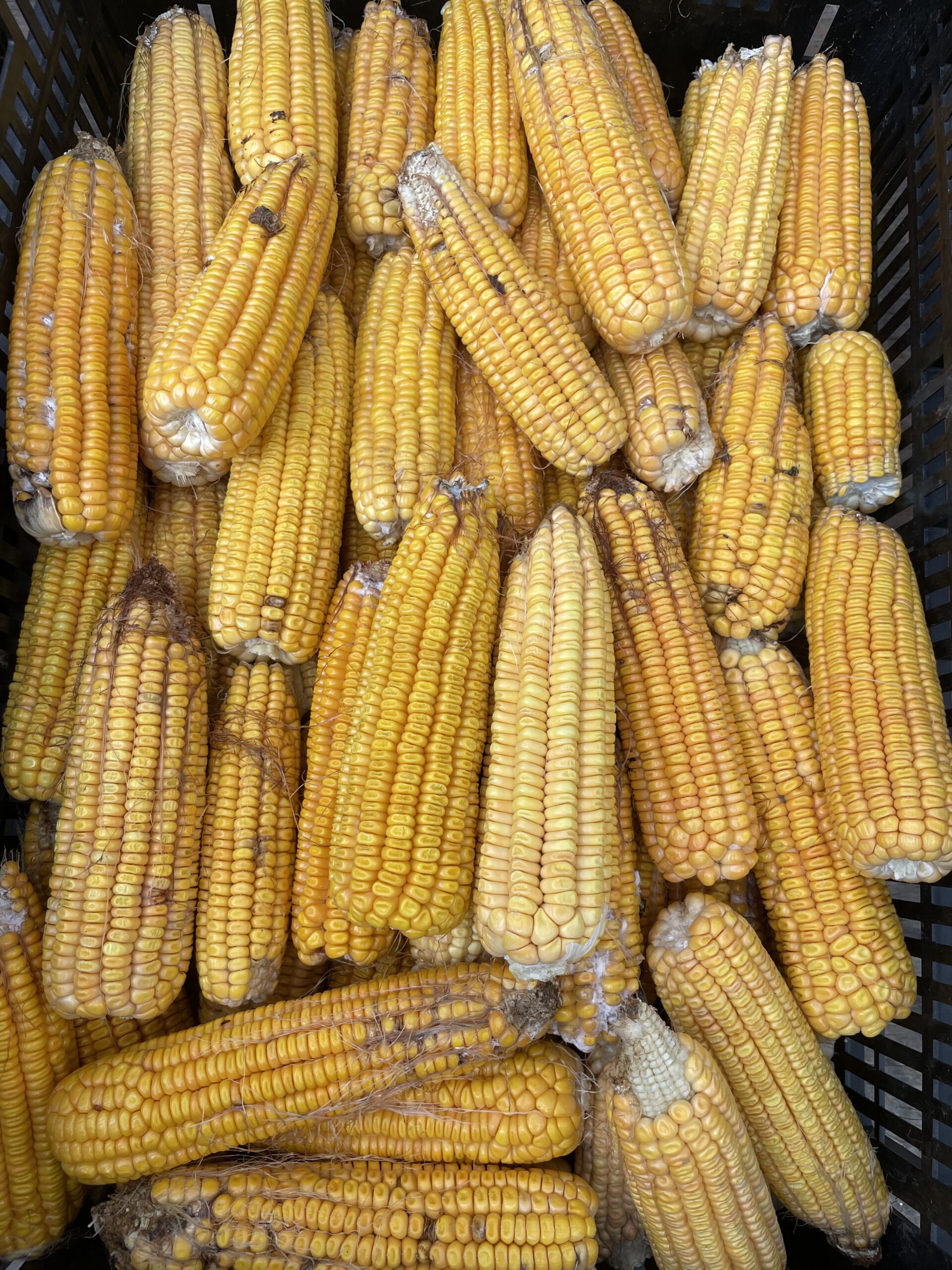 Throughout the duration of the research project, we tracked the following:
Throughout the duration of the research project, we tracked the following:
- seed germination by percentage
- pest and disease damage to each plot in SARE A by percentage
- weed pressure by percentage
- plant stage growth and maturation by height and stage of development.
Oats
For the oats cultivation, activities began on March 10th with a team of two staff members who were responsible for preparing the field. This preparation involved removing the silage tarp, forming beds, and employing a BCS 579 rotary plow to create 29 raised beds within a 75x150 square ft area. Planting the oats took place between March 17th and 18th, 2023, using Earthway seeders for seeding 30-inch beds. The oats were weeded with a diamondhead hoe and a tine weeder for a total of four hours across the growth period of April 19th and June 12th.
Harvesting was carried out manually using scythes from July 29th to 31st, 2023. Two staff members and four interns, totaling 16 hours. The grains' moisture was monitored daily with an Agtronix grain moisture tester, a week prior to the harvest. We needed to ensure moisture levels were below 15% before processing. After harvest, the oats were dried and stored in a climate-controlled facility from July 28th to August 4th, 2023.
On August 4th, the oats underwent a manual processing at Migrash, a local mill, involving three staff members and two interns. This process included threshing, cleaning, sorting, rolling, and packaging the oats for (rolled) oats AKA "oatmeal". The yield was approximately 50 lbs of Streaker Hulless oats from 13 of the planted beds, equivalent to 3250 sq ft. We sold twelve 2-pound bags at our farm stand for $5 each, retained 7 pounds of unrolled oat seed, and recorded a loss of approximately 12 lbs during the seed cleaning process. The oats cultivation faced several challenges, notably in weather and labor management. Preparing the fields in a timely manner after the soil testing and the difficulties in scheduling the contractor, lead to manual bed preparation which added quite a bit of time. Building raised beds rendered the ability to utilize mechanized harvesting, impossible; placing additional pressure on our manual labor resources.
Despite facing significant challenges, including the physical demands of harvesting, unpredictable weather conditions, and the transition to manual harvesting techniques, our team successfully grew and harvested marketable oats. Embracing these hurdles as opportunities for growth, we actively sought wisdom and insight from experienced grain growers.
Corn
Over the span of March 17th to April 12th, Purple Mountain Organics served as a contractor and readied our 10,000 sq ft corn field with a suite of mechanized tools; performing subsoiling, plowing, cultivating, and enriching the soil by spreading 60 cubic yards of compost. Between June 29th and 30th, we devoted 8 hours to further cultivation and setting up an electric fence. Prior to planting, our team provided a practical demonstration to share our methods and insights. On July 12th, using a Jang seeder and a collaborative effort between three interns and a staff member, we sowed Reid's dent corn seeds across the field.
Drawing lessons from our oat cultivation, we opted against constructing raised beds for the corn, a decision that led us to forgo precise bed counts. Instead, we focused on the broader field area, with corn ultimately covering 7,000 sq ft. The harvest on November 7th and 8th saw the combined efforts of three staff members and eight volunteers, contributing to a total of 24 staff hours and 32 volunteer hours. The following day, our corn was transported to Next Step Produce, where by December 14th, the grain was dried and processed into 230 pounds of shelf-stable corn food products; including cornmeal, grits, flour, and approximately 50 pounds of animal feed/"chicken scratch".
Our processed corn was packaged into both 2 lb and 8 oz bags, to be sold at local farmers' markets, Farm Alliance events, our online store and regional farmer conferences such as Mid-Atlantic Black Farmers Conference, the Baltimore Urban Ag Winter Meeting, PASA and Future Harvest-CASA. Heeding the advice from Next Step Produce and Purple Mountain Organics, we set our prices at roughly $3.66 per pound. This price strategy, informed by our market research, revealed a preference for the smaller 8 oz bags. The unintended selection of 8 oz bags offered us valuable insights into customer purchasing behavior. Moreover, unlike much of the commercially available products, our products boasted a freshness guarantee of 6 months from processing; underlining our commitment to quality, freshness, nutrient density.
The corn harvest presented a more streamlined and fulfilling experience compared to the oat cultivation. We faced a setback with an estimated loss of 50-75 lbs of yield due to corn smut, an affliction caused by the fungus Ustilago maydis, which produces swellings on the corn's ears, leaves, stalks, and tassels. Approximately 80 lbs of affected corn was discarded to maintain the quality of our harvest.
Following the collection of the corn, we immediately took steps to rejuvenate the soil by sowing a diverse mix of cover crops, including Austrian winter pea, daikon radish, vetch, and clover, which unfortunately did not establish as hoped. Persisting in our efforts to enhance soil health, we initiated a second round of cover crop planting with clover, vetch, and peas in March 2024.
Peanuts
Securing the Carolina African Runner peanut seeds presented a unique challenge. During the winter months of 2023, we reached out to various sources, including Clemson University and Sow True Seeds, in pursuit of 10 lbs of these specific peanut seeds. We successfully acquired 250 seeds of the sought-after Carolina African Runner variety, which arrived in the spring of 2024.
We dedicated a 62.5 square foot area (2.5ft x 25ft) for the peanuts, organizing them into a single row with a 10-inch spacing. We were unable to yield a significant harvest.
Soil Quality
Throughout this project, we engaged in over 15 hours of soil coaching, based on the results of the soil tests' results. This valuable program brought soil health experts and specialists on board to offer tailored advice, support, and information on soil management practices suitable for our specific farm location. The soil coaching process included an on-site visit, soil testing, and assistance in interpreting the results and implementing recommendations. Our soil coaches were Dana Rusovich, an NRCS agronomist, and Leslie Lewis from Living Systems Soil LLC, whose expertise was instrumental to our soil health improvement efforts.
As part of our commitment to monitoring and enhancing soil quality, we conducted soil tests on all fields during the spring and fall of 2023. To improve soil fertility and structure, we introduced cover crops such as Austrian winter pea, hairy vetch, red clover, daikon radish, and rapeseed in Fields A and B during the summer/fall of 2023 and again in spring 2024. The daikon radish, rapeseed, and vetch showed particularly robust germination and growth, indicating their effectiveness in contributing to soil health and biodiversity on our farm.
See tables below for summary of both fields:
Table A: Field Analysis (Oats)


2022
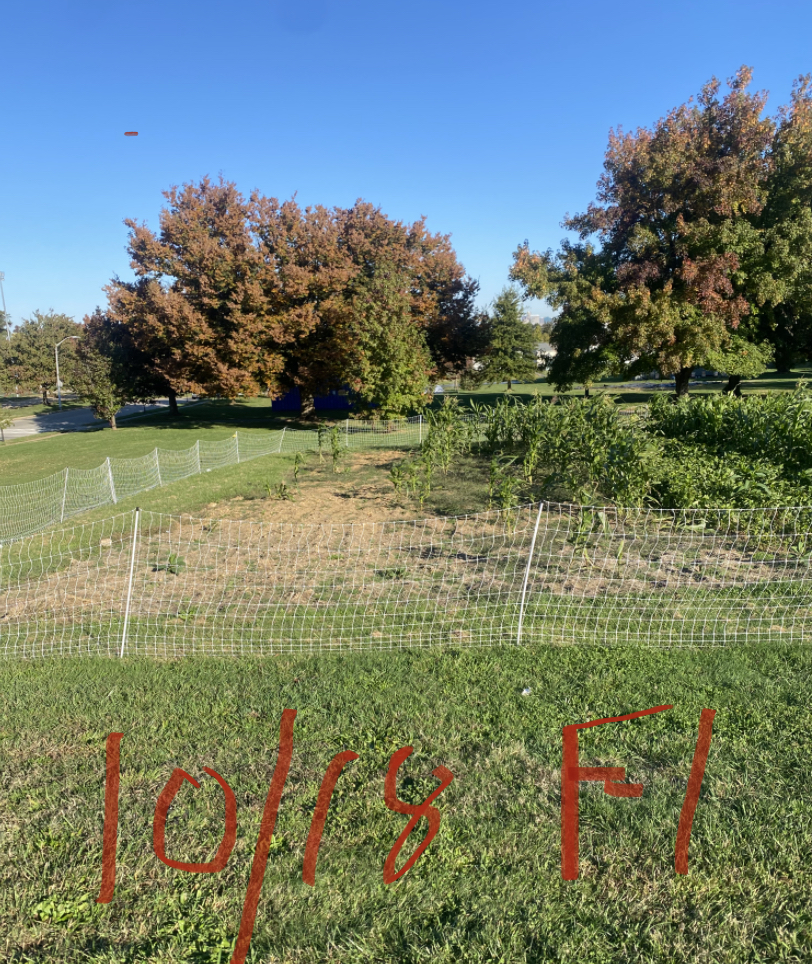


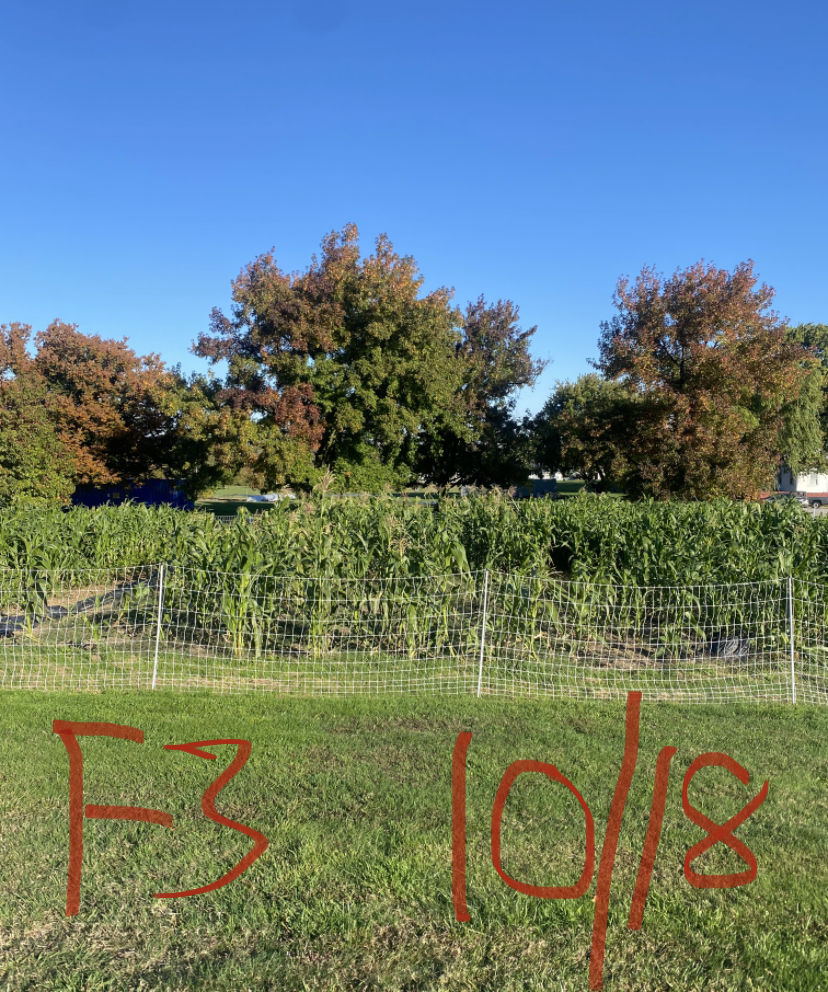
Our research sought to answer the question if we establish an economic and marketing framework for growing oats and dried beans as a food crop. The understanding was that those plants have a lower extraction impact and higher return benefit on soil health. However, due to constraints beyond our control and not having access to the proper equipment, we did not yield a marketable harvest from either.
We concluded this study by successfully producing about 18 pounds of rolled oats. Which I would consider, a success at this scale.
In the 2023 season, we pivoted and decided to grow a much more manageable grain crop by the advise of our farmer-mentors. We successfully grew roughly 240 lbs of shelf-stable, market-ready corn product. We packaged and sold them as grits, cornmeal, and corn flour.
Rolled oats were sold at in 16 ounce bags for $5/lb at the farmers market. We sold 12 bags and they all sold out on the first day.
Our first batch of bagged corn products went to Waverly Farmers Market and a popup holiday market.
This project involved the Farm Alliance staff as a whole. Myeasha Taylor and Andrew Szentendrei were the primary leads on this project but it involved the professional insight and expertise of the rest of the staff to be completed successfully.
|
# of people |
Total Hours |
|
|
Interns |
8 |
80 |
|
Trainees |
10 |
40 |
|
Staff |
7 |
620 |
|
Volunteers |
7 |
30 |
|
Contractors |
5 |
40 |
- Project Insights: Lessons learned from the project that could inform future endeavors.
- Take your soil test as soon as possible
- Build a contingency plan to mitigate potential changes that will impact the timeline of the full life cycle of the crops of choice
- Identify and study the crop soil preferences, needs and harvest/post harvest handling for the grains/legumes of your choice
- Follow the instructions from the soil test results and be okay with changes in the project
- Identify at least 2-3 contractors immediately who can provide the services as a contingency plan
- Assess staff capacity for what can be accomplished without mechanization, water, and reliable labor
See our results from soil tests over the duration of this project below:
Soil Test Analysis Table C: SARE A and SARE B fields
2022 Analysis
Because the seed of black eyed peas were sold out, we grew iron clay cowpeas, oats and dent corn variety called Rebellion. We chose Rebellion because of its resistance to GMO-varieties cross-pollination.
Our first planting of oats was in fall 2022 instead of spring 2022. We were expecting our partners to prepare and no-till drill the seeds in spring 2022. Unfortunately, both contractors experienced their own hardships and thus were unable to support us and meet the expectations we agreed upon. As a result, we had to purchase the seeding and cultivating equipment, borrow a walk-behind tractor to prepare and plant the fields and plant the seed. These limitations made it impossible for us to plant during the recommended window to allow enough time for growing days and “dry-down” for us to gather a harvest.
Positive changes included doing an ad hoc seeder trial with the Black Butterfly trainees comparing the use and efficacy of a Jang seeder versus an Earthway seeder when seeding the corn and cowpeas. From that experiment, we decided to use the Jang seeder as our preferred technology for seeding the rest of our experiment plots.
Education & outreach activities and participation summary
Participation summary:
We provided 30 hours of educational training to the 2022 Black Butterfly Urban Farmer Academy cohort and public including being published in the Farm Alliance’s newsletter, public events on the farm, and presenting at the Black Urban Growers conference and the 11th Annual National FIELD School conference.
We offered a public event in collaboration with the University of MD Extension Farmer Field School. During this workshop, we explained and shared our research including our data collection methods, expenses, and challenges. We provided training to volunteer participants on how to use Earthway and Jang seeders.
During our annual garlic planting, we provided two tours to community members.
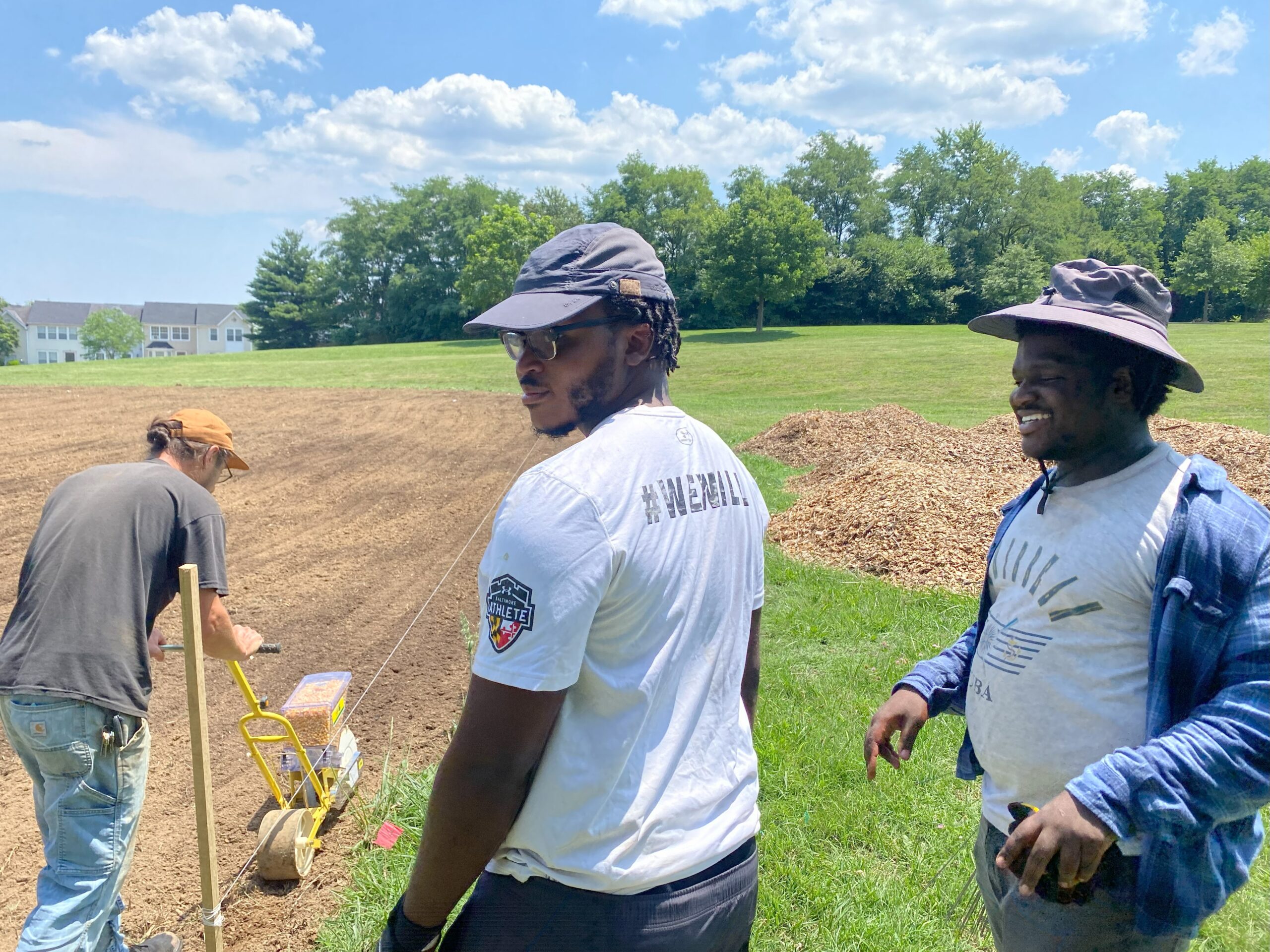
Learning Outcomes
- how to conduct farm research and collect data
- how to grow small grains and dried beans
- how to plant oats and or legumes using mechanized tools for cultivating and planting
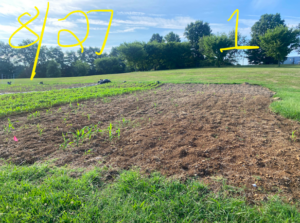
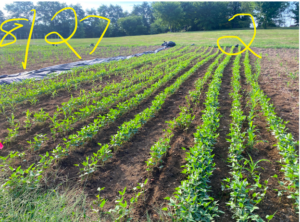
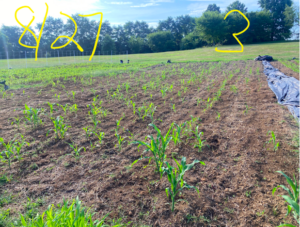
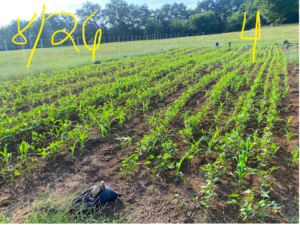
Project Outcomes
Our project was designed to demonstrate what can be achieved on a quarter acre (10,000 sq ft) plot in an urban agriculture setting. The trainees of the Black Butterfly Urban Farming Academy were instrumental in assisting us execute this project, including cost, labor and data collection. They expressed an interest in farming for research and growing high caloric food. This project also has changed our thinking about production methods and shifted us to exploring the practice of growing storage and bulk crops that have a longer shelf life. Often, farmers are stressed about direct market outlets with highly perishable produce. This project has allowed us to take our time and build a field where soil health, conservation and yields are prioritized simultaneously.
This project encouraged us to plan for risks and foreseeable challenges as most farmers do. However, the challenge was planning for risks and challenges for a crop none of the team were familiar with. This project is our first research project at the Black Butterfly Farm. We were unable to fully execute our plan over the season because of a lack of equipment and difficult timing. We revised our methodology by tracking growth in the corn and the health of the soil, recognizing that we were not necessarily going to have a corn or bean harvest. This change in methodology inspired us to problem solve around how to capture relevant data for our hypothesis.
Our key challenges were an inability to complete field prep including having access with mechanized equipment, there were scheduling conflicts with the contractors and our seed was planted too late in the year. Due to the aforementioned challenges and the threat of the season’s first frost, we were unable to address our hypothesis around the profitability of small grains and legumes. We did not harvest legumes or corn. They did not reach full maturity.
Our two key successes were using new seeder technology and experimenting with research on our teaching farm. Additionally, we had a soil coaching session with our local Natural Resources Conservation Service agent that informed us of how to improve and maintain our soil health. We also had advisory calls with our technical advisor and Extension agent, Marcus Williams. on data points to record, such as the stages of the plant. Learning about the life cycle of the plants informed the data we collect and observe.
At the conclusion of this year of the project, and with the advice of the technical advisor and soil agronomist, we were informed that our soil pH needs to be amended to create optimal growing conditions for the desired crop.
We will continue with our project goals and modify our project’s procedures in 2023 by having our equipment and infrastructure prior to planting, seeding an “easy kill” cover crop in the spring for Plots A and B, raise our soil’s pH by adding compost and organic lime-based amendments in liquid form, solarize and cultivate fields to mitigate weed pressure. We will expand our experiment this upcoming season with different types of legumes and grains over the duration of this project including using heirloom varieties of corn and peanuts.
Additional work includes seeking advice from grain and legume farmers in the Mid-Atlantic (USDA Plant Hardiness Agricultural Zone 7A) and formalizing our data collection template that is easily accessible digitally.
Our project results would be most beneficial to urban farmers, socially disadvantaged farmers, and refugee farmers.
